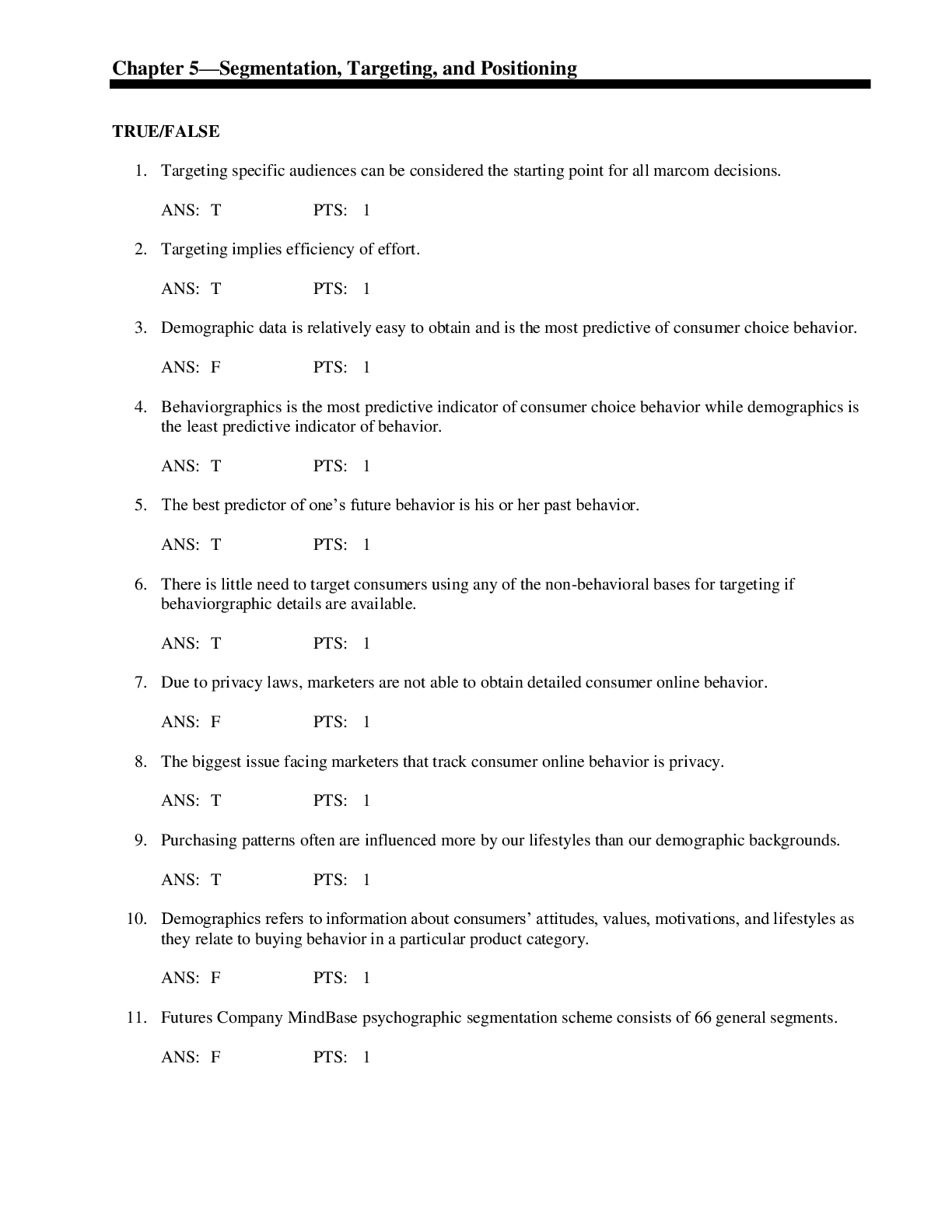*NURSING > QUESTIONS & ANSWERS > Nursing/Community Health: Questions and Answers Questions and Answers (All)
Nursing/Community Health: Questions and Answers Questions and Answers
Document Content and Description Below
1. A nurse conducting a community health education program stresses that Lyme disease is caused by a _____________. a. Spirochete b. Virus c. Parasite d. Helminth 2. When conducting a community... education program related to Lyme disease, the nurse stresses that if left untreated, Lyme disease result in which of the following? a. Respiratory failure b. Acute renal failure c. Cardiac dysrhythmias d. Permanent skin lesions 3. Maria brought her 10-year-old child to the clinic. She was concerned that the child could develop Lyme disease because a deer tick was found on the child. The nurse tells Maria that infection with Lyme disease is likely if the deer tick a. Was large b. Was attached to the child’s skin for at least 24 hours c. Caused bleeding d. Remained attached for at least 1 hour 4. Systemic lupus erythematosus is a. An acute autoimmune disease b. The result of hyperactivity of killer T cells c. A chronic multisystem inflammatory disease d. More common in men aged 20 to 30 than in women in that age group 5. The nurse conducting a health education program as part of a PTA meeting stresses that gastrointestinal infections are more likely to occur in people who a. Smoke b. Are lactose intolerant c. Take antacids d. Eat a spicy diet 6. During an orientation session for new hires, the nurse educator stresses that some pathogens can survive on bed rails and tables for a. 30 minutes to an hour b. Weeks c. 5-20 minutes d. 2-3 months 7. Which of the following statements about a fever is correct? a. A fever is generally harmful. b. Oral prednisone masks a fever. c. A fever suppresses the action of macrophages. d. A rectal fever of 99.6 °F in children indicates serious infection. 8. During an in-service in a long-term care facility, the nurse educator stresses that in the elderly (select all that apply) a. Infection usually produces a fever above 101°F. b. Changes in mental status may indicate an infection. c. Fatigue is a possible sign of infection. d. A fever 2 degrees above baseline requires immediate attention. 9. What is the most accurate test to detect HIV infection currently on the market? a. ELISA b. OraSure c. Western blot d. B-cell analysis 10. Which of the following statements about HIV is true? a. HIV infects CD8 T cells. b. HIV uses reverse transcriptase to convert its RNA to DNA. c. HIV infections can be completely eradicated by the use of antivirals. d. HIV infection initially causes pronounced signs and symptoms. 11. The role of histamine in the inflammatory process includes a. Initiating vasoconstriction to limit bleeding b. Coating pathogens for easier phagocytosis c. Promoting hyperthermia d. Increasing capillary permeability 12. Which of the following statements about chronic inflammation is true? a. Chronic inflammation lasts 5 to 7 days. b. Chronic inflammation results in granuloma formation. c. Chronic inflammation results from viral infections. d. Chronic inflammation produces copious amounts of serous exudate. 13. Granulocytes a. Produce antibodies b. Include killer T cells c. Contain enzymes capable of killing bacteria d. Arrive at the site of cell injury in approximately 24 hours 14. Macrophages a. Are involved in debris cleanup at the inflammatory site b. Are responsible for producing allergic reactions c. Live approximately 120 days d. Are immature monocytes 15. Which of the following statements about B cells is correct? a. B cells provide cell-mediated immunity. b. B cells produce antibodies. c. B cells release histamine. d. B cells live approximately 3 months. 16. Which of the following statements about suppressor T cells is true? a. Suppressor T cells turn off antibody production. b. Suppressor T cells mature in the bone marrow. c. Suppressor T cells are the most numerous type of T cell. d. Suppressor T cells release lymphokines that destroy pathogen cell walls. 17. The antibody classified as IgE is responsible for a. Passive immunity b. Protecting the lungs from infection c. Activating complement d. Allergic reactions 18. Research has indicated that chemokine receptors (CCR5 and CXCR4) a. Are found on human immunodeficiency virus particles b. Allow the human immunodeficiency virus to enter CD4 cells c. Protect HIV-positive individuals from developing opportunistic infections d. Are responsible for neoplasm development 19. The complement system a. Causes the release of histamine from mast cells b. Causes clot formation at the site of cell injury c. Is another name for T cells d. Includes bradykinin [Show More]
Last updated: 2 years ago
Preview 1 out of 7 pages

Buy this document to get the full access instantly
Instant Download Access after purchase
Buy NowInstant download
We Accept:

Reviews( 0 )
$10.00
Can't find what you want? Try our AI powered Search
Document information
Connected school, study & course
About the document
Uploaded On
Apr 15, 2020
Number of pages
7
Written in
Additional information
This document has been written for:
Uploaded
Apr 15, 2020
Downloads
0
Views
93






.png)
.png)
.png)
.png)
.png)
.png)
.png)













